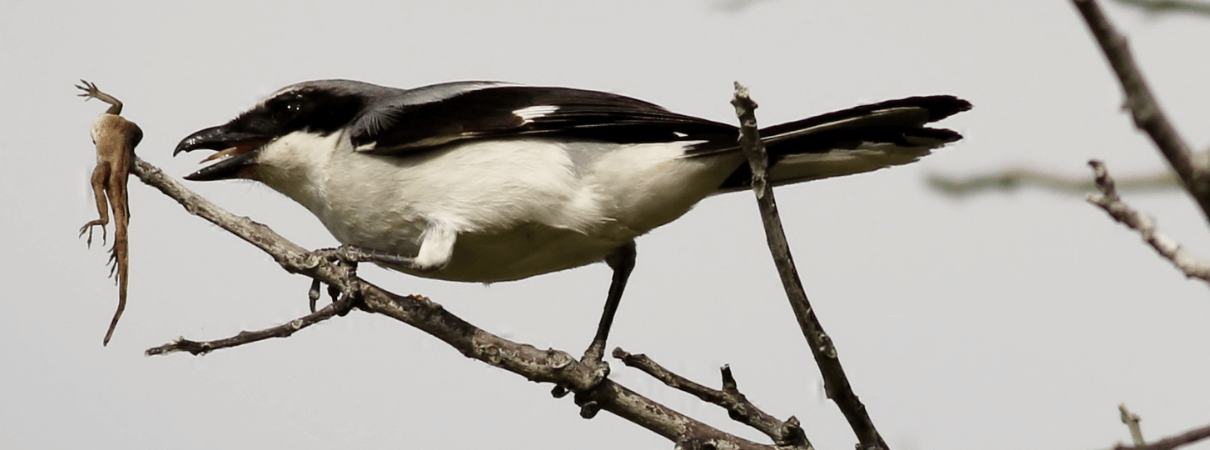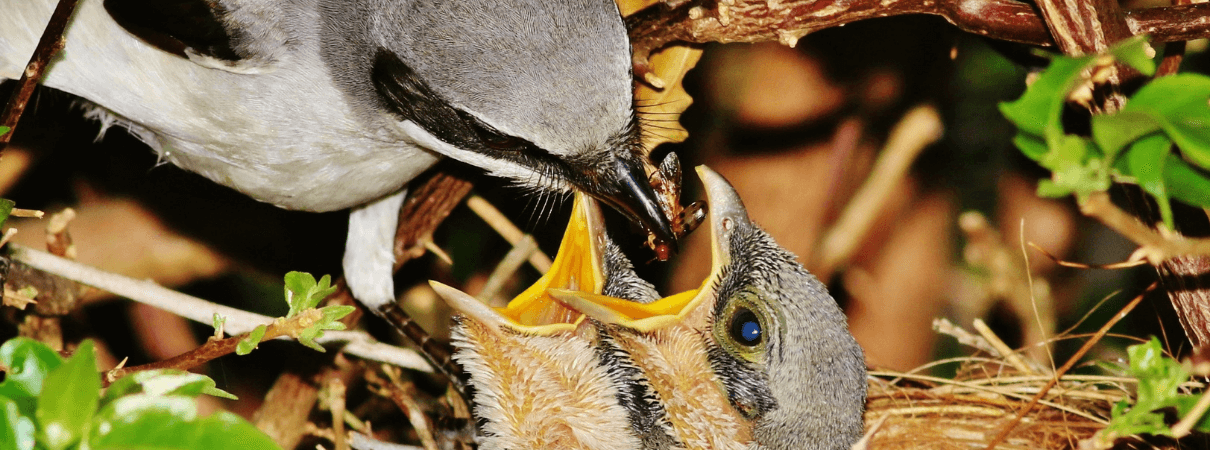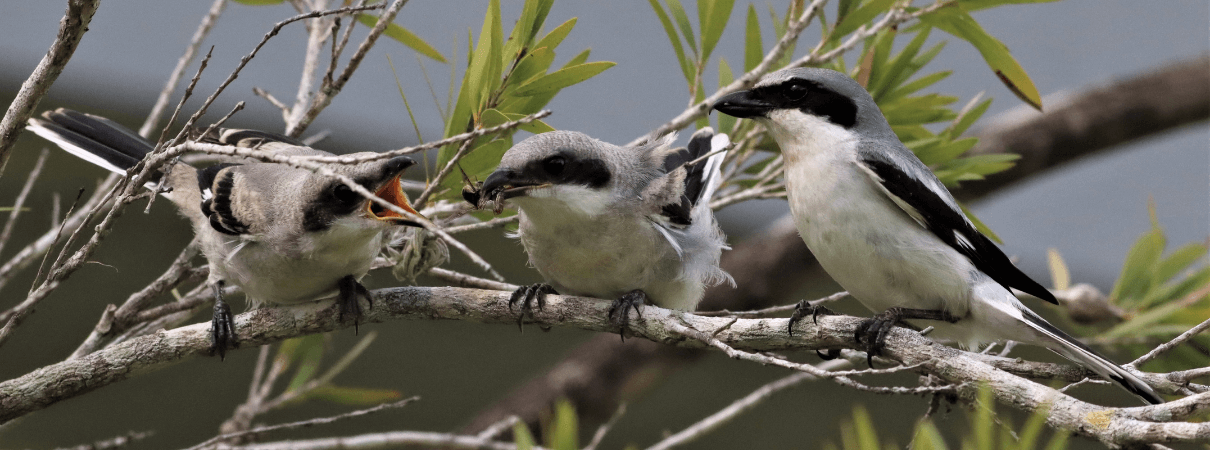What Makes Shrikes So Unique? Spiked Snacks, Shrieking Calls, and More
If you know one fact about shrikes, it's probably that they impale their prey on thorns — but there's so much more to these stand-out birds than their macabre dining habits. The ancestors of shrikes, which are closely related to crows and ravens, may have first evolved in Africa between 20 and 25 million years ago. Today, these supremely effective predators thrive from the Arctic to the tropics, although in recent years, many populations have declined along with their habitats.
To help you get to know this fascinating group of birds, we've assembled answers to some of the most common questions about them, including what shrikes look like, how they hunt, what threats they face — and how you can help. (And yes, we are going to talk about impaling, too.)

Loggerhead Shrike with snake. Photo by Kristian Bell/Shutterstock.
What is a shrike?
“Shrike” is the common name for predatory birds in the family Laniidae (not to be confused with other birds with similar-sounding names like the antshrikes or the shrike-tits). According to some sources, the word comes from an Old English word for “shriek” and is a reference to the sound of these birds' calls.
Listen here:
(Audio: Andrew Spencer, XC91970. Accessible at https://www.xeno-canto.org/91967)
Shrikes' key physical characteristics include hooked bills, big heads, upright posture, and short, thick necks. Most species are colored in blacks, grays, and earth tones and have distinctive black “mask” markings over their eyes, which may help cut down on glare when the birds are hunting. Depending on the season, these robin-sized predators can be found in open habitats such as grasslands and forest edges throughout much of the United States.
How many species of shrikes are there?
The shrike family includes 33 species organized into three genera. Most species live in Eurasia and Africa. Only two, the Loggerhead Shrike and the Northern Shrike, are found in North America (though the Northern Shrike's range also includes much of northern Asia). The Northern Shrike is predominantly migratory; most of its population moves each year except some permanent residents in coastal Alaska. On the other hand, about two-thirds of the Loggerhead's range is occupied by shrikes year-round.

Northern Shrike. Photo by Glenn Bartley.
How do you identify shrikes?
Identifying North America's two shrike species, the Northern Shrike and the Loggerhead Shrike, can be tricky. At first glance, they look very similar — both are gray above and white below, with black masks and black on their wings and tails. If you get a close look, though, there are subtle differences to keep an eye out for. The Northern Shrike has light, wavy grayish barring on the underparts, lighter-gray plumage on crown and back, and a narrower black mask that doesn't wrap over the top of the bill and eyes. Depending on the time of year and where you are, your biggest clue might be range: Only Loggerhead Shrikes are found in the lower 48 U.S. states during the summer, as Northern Shrikes breed much farther north, in Arctic and subarctic habitats.

Northern Shrike (left) and Loggerhead Shrike (right). Photos by Tom Reichner/Shutterstock and Serenity23/Shutterstock.
Do shrikes kill birds?
Yes, shrikes kill birds. Consummate carnivores, they hunt from exposed perches and eat whatever small animals are available in their environment. Often, this means insects, but shrikes do also kill and eat small vertebrates, including rodents, lizards, and sometimes other birds. Northern Shrikes in particular have been documented to successfully go after birds much larger than themselves, including ducks and pigeons — and some even claim that the Northern Shrike imitates the songs of other birds to lure them in.
Why do shrikes impale their prey?
After a shrike kills another animal, it often impales its prey on a thorn or barbed wire fence to store it for later. The bird will then return and pick at its meal over the course of several days. Waiting to eat prey gives the toxins found in some insects time to break down. This is the behavior that these birds are most infamous for, and it's earned them the nickname “butcherbird,” as well as providing inspiration for the names of several fictional serial killers and monsters. The family's Latin name Laniidae also comes from the Latin word for butcher.

Loggerhead Shrike with impaled lizard. Photo by Philip Rathner/Shutterstock.
Are shrikes raptors?
No — believe it or not, they are songbirds! Their raptor-like features, most notably those wickedly hooked beaks, are likely due to convergent evolution. Because both shrikes and raptors (a group that includes eagles and hawks) have specialized in killing and eating small animals, natural selection left them with similar traits. But on the bird family tree, shrikes are actually part of a larger group of birds called the “passerines,” which are commonly referred to as songbirds. Although they're not exactly the bird world's best singers, some shrike species do have songs, of a sort.
Listen here:
(Audio: Andrew Spencer, XC91967. Accessible at https://www.xeno-canto.org/91967)
How do shrikes nest and raise young?
Most shrikes are monogamous, with a single male and female working together to raise their young. Females do most of the actual nest construction, building open-cup nests that might contain anywhere from two to nine eggs, depending on the species and where it lives. A few species (although not the ones in North America) are cooperative breeders, with family groups of up to nine birds staying together to help raise the young of a single breeding pair!

Loggerhead Shrike feeding chicks. Photo by Philip Rathner//Shutterstock.
Are shrikes rare or endangered?
Most of the world's shrike species, including the Northern Shrike, are designated as “Least Concern.” There are exceptions, though.
In North America, the Loggerhead Shrike is rated as “Near Threatened.” Its range has contracted dramatically in the north, especially from the prairies of south-central Canada into southern Ontario, where the birds have nearly disappeared. This is most likely due to the loss of human-created habitats that support shrike populations, including unimproved pasture and hedgerows. In addition, there is data suggesting that the use of insecticides may also play a role in this species' decline. Overall, Loggerhead populations declined by 76 percent over the last 50 years, and they continue to drop by as much as five percent per year.

Loggerhead Shrike adult (right) and young. Photo by Philip Rathner/Shutterstock.
A subspecies unique to California's Channel Islands, the San Clemente Loggerhead Shrike, has been listed under the Endangered Species Act since 1977 and has been the subject of intensive management, including predator control and captive breeding.
And although the Northern Shrike is doing well for now, its Arctic range is vulnerable to climate change, and this species could lose more than three-quarters of its habitat if global temperatures rise by 1.5°C.
The most endangered shrike species in the world is the Newton's Fiscal, a black-and-yellow bird found only on a single island, Sao Tome, which sits on the equator off Africa's Atlantic coast. It is considered Critically Endangered. After a 1928 research expedition collected 13 specimens of the species, no one saw it again for 60 years. Scientists assumed it was extinct until an individual bird was spotted in the 1990s. The total population today is probably no more than 50 individuals, and much of the species' forest habitat is degraded or already gone.
How can I help shrikes?
We all can do our part to protect shrikes.
American Bird Conservancy and our Joint Venture partners have improved conservation management on 6.4 million acres of U.S. bird habitat — an area larger than the state of Maryland — over the last ten years. This is a monumental undertaking, requiring the support of many, and you can help by making a gift today.
Policies enacted by Congress and federal agencies, such as the U.S. Fish and Wildlife Service, have a huge impact on America's birds. You can help shape these rules for the better by telling lawmakers to prioritize birds, bird habitat, and bird-friendly measures. To get started, visit ABC's Action Center.
 | Rebecca Heisman is a science writer based in eastern Washington. Her first book, which tells the scientific backstory of how we know what we know about bird migration, will be out in spring 2022. |


















































